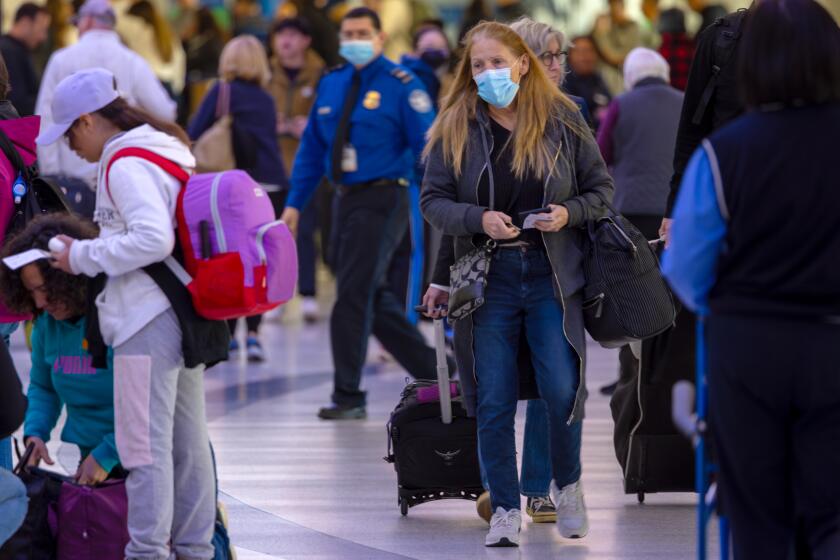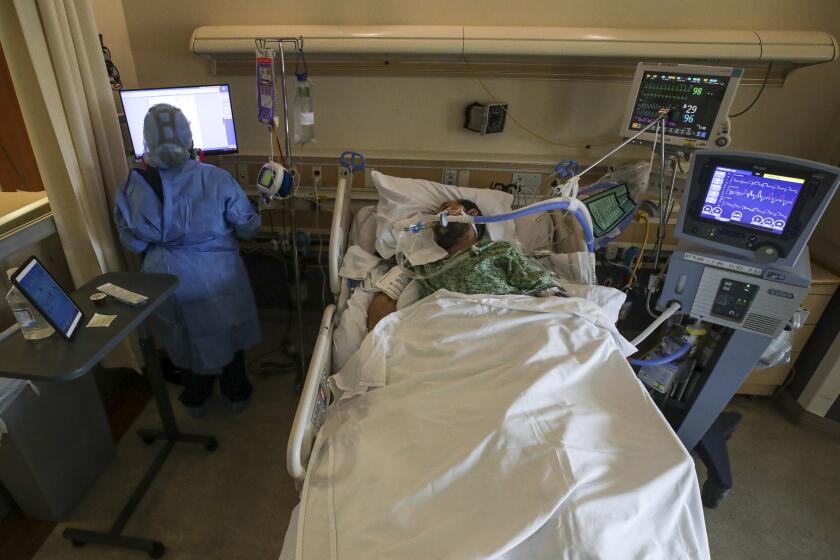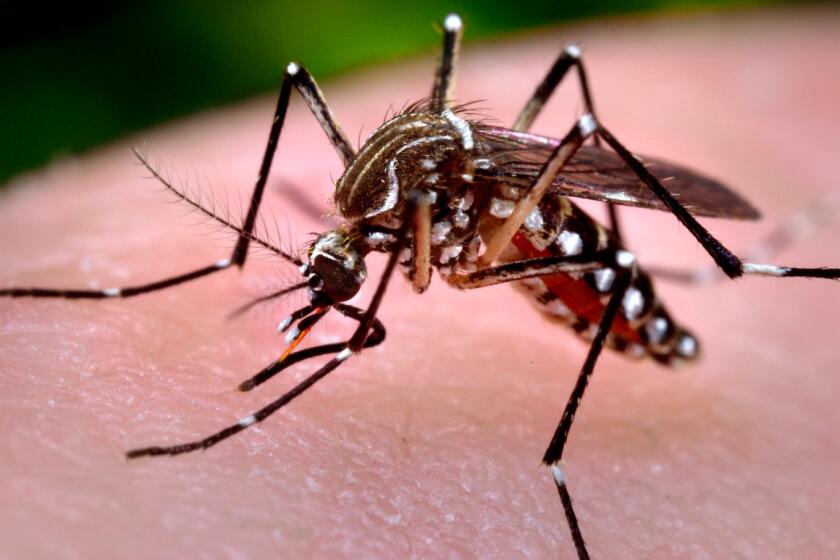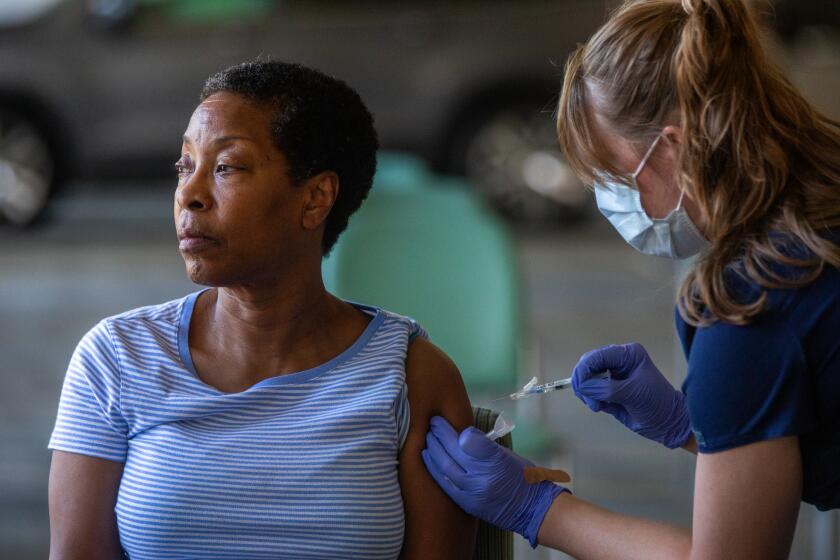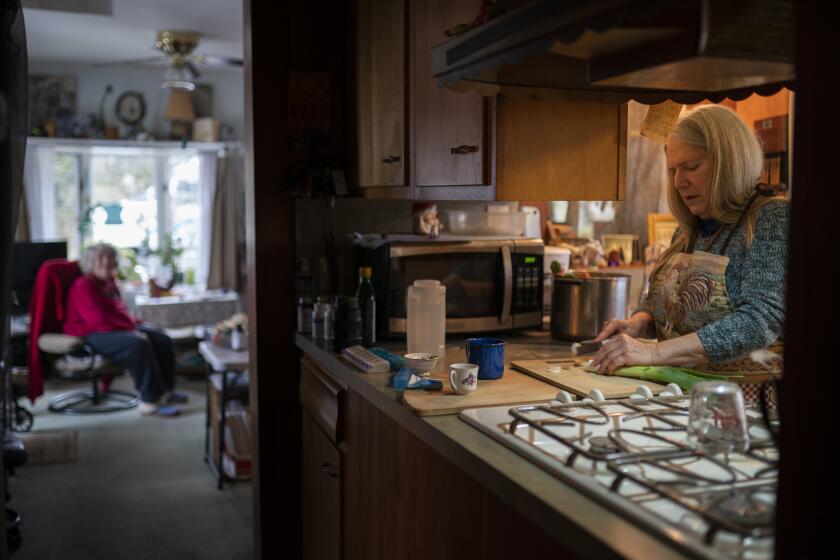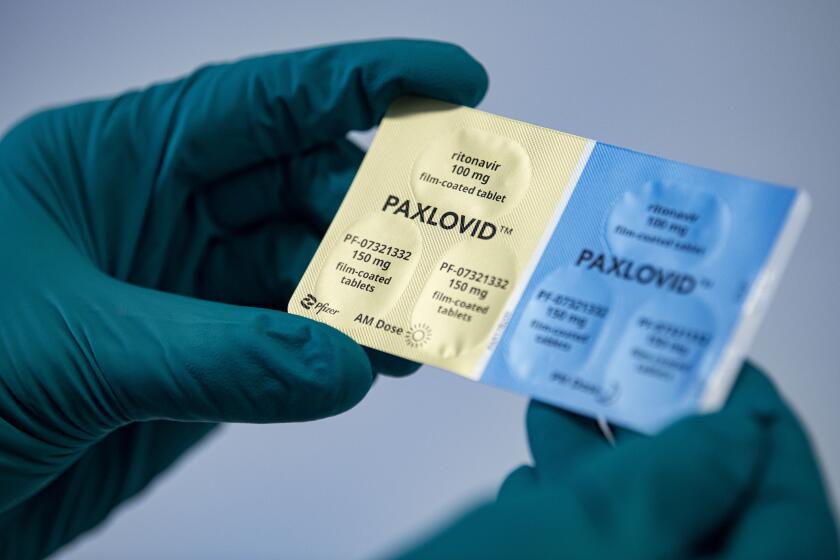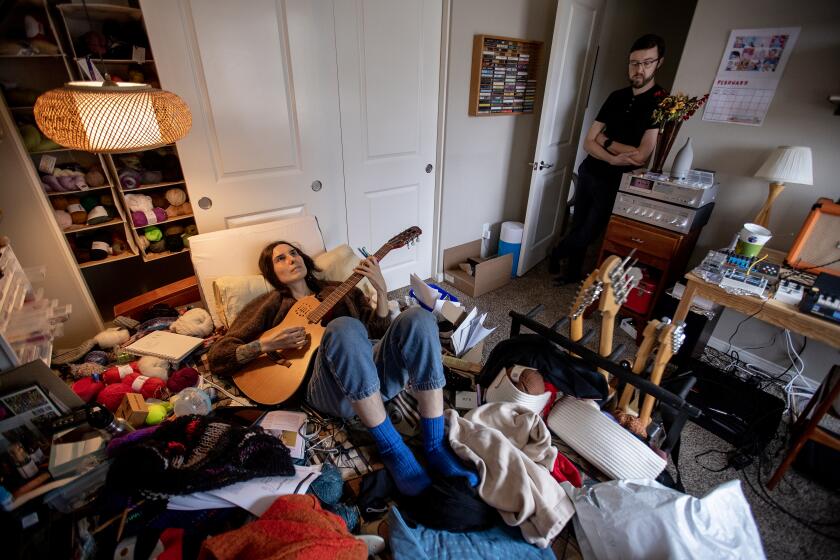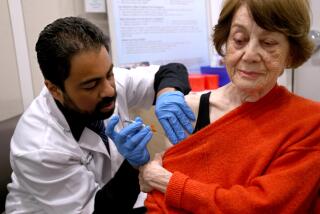Signs of rising COVID in California as new FLiRT subvariants dominate
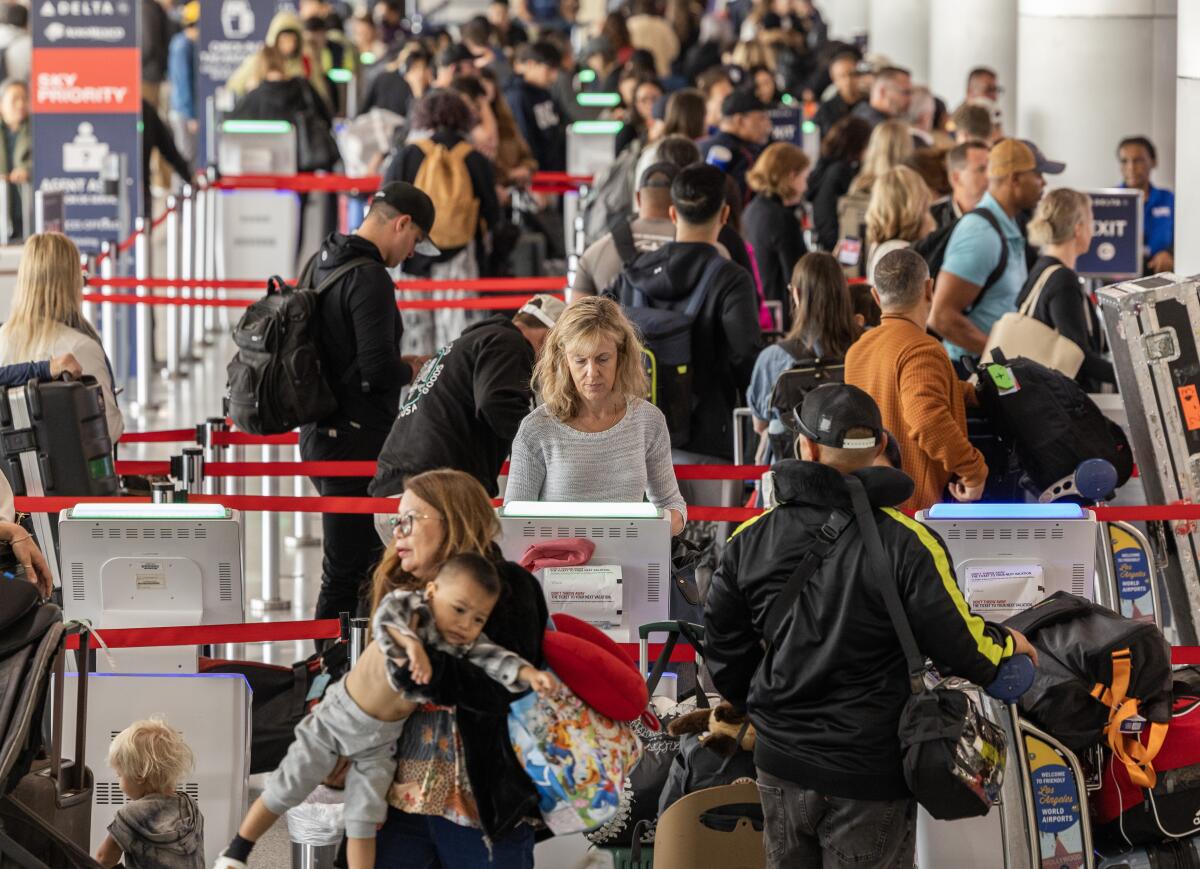
- Share via
California may be headed to an earlier-than-normal start to the summer COVID-19 season, with coronavirus concentrations in sewage rising in some areas along with the statewide positive-test rate.
The trend comes as the latest family of coronavirus subvariants, collectively nicknamed FLiRT, have made significant gains nationally.
The FLiRT subvariants — officially known as KP.2, KP.3 and KP.1.1 — have overtaken the dominant winter strain, JN.1. For the two-week period that ended Saturday, they were estimated to account for a combined 50.4% of the nation’s coronavirus infections, up from 20% a month earlier.
Instead of California seeing reduced circulation of COVID-19, as occurred earlier this spring, state health officials said that they estimate the spread is now either stable or slowly increasing.
“COVID-19 concentrations in wastewater have suggested increases in several regions across California since early May. Test positivity for COVID-19 has been slowly increasing since May,” the state Department of Public Health said in a statement to The Times on Friday.
In years past, summer travel and gatherings have spurred surges in coronavirus infections. As immunity wanes for those who received the most recent vaccine, experts urge caution.
Over the seven-day period that ended Monday, about 3.8% of COVID-19 tests came back positive; in late April, that share was 1.9%. (Last summer’s peak test-positive rate was 12.8%, at the end of August.)
Doctors at hospitals in Southern California and the San Francisco Bay Area are also seeing an uptick in coronavirus spread.
“We’re certainly seeing a bit of a small increase. And this is all due to the so-called FLiRT variants,” said Dr. Elizabeth Hudson, regional chief of infectious disease at Kaiser Permanente Southern California.
The increase has so far been seen primarily in outpatient cases at Kaiser.
“Anytime there’s a new variant, then, unfortunately, the new variants will have the ability to [overcome immunity resulting from prior infection], and if it’s been awhile since someone has been vaccinated, they obviously will not have the same level of protection as someone who was more recently vaccinated,” Hudson said.
This past winter, the mortality rate for patients hospitalized with COVID-19 was 35% higher than for patients hospitalized with the flu.
In San Francisco, infectious disease doctors are noticing more people in the hospital with COVID-caused pneumonia.
“I have seen more than I would expect, of sick people in the hospital” for COVID, said Dr. Peter Chin-Hong, a UC San Francisco infectious diseases expert. The number was just a handful, “but it’s definitely noticeable.”
Based on his reading of wastewater data, “we know that it’s up, and it’s up earlier,” Chin-Hong said of coronavirus activity.
“Last year, I think it was late June when it started going up, and this year it’s, like, now it’s late May. So it’s a little bit earlier, but we’re starting from a very low place,” Chin-Hong said.
And anecdotally, people in the Bay Area are talking about COVID more, it seems, Chin-Hong said. He recalled hearing about someone’s child’s classroom dealing with a COVID case a few days ago.
“It’s not necessarily an alarming number now, but it is ... the beginning of the summer, so that’s what we expect,” Chin-Hong said.
Two years after millions of state dollars started to flow into the state’s chronically underfunded public health system, the governor has proposed cutting all of the COVID-era funding to help close a budget deficit.
The Los Angeles County Department of Public Health has also started to see a very small uptick in cases in recent days.
From May 10 to 15, the most recent data available, there were an average of 82 to 92 COVID-19 cases per day, an increase from earlier in the spring. There were an average of 60 to 80 new cases a day between March 25 and May 9, L.A. County health officials said in a statement to The Times. The case counts typically reflect tests done at medical facilities and don’t include home tests — nor do the tallies account for infections among people who don’t test.
“It’s too soon to tell if this very small increase in recent days will become a sustained uptick. These case counts are low, making it difficult at this time to assess real trends,” the L.A. County Department of Public Health said.
Coronavirus levels in L.A. County wastewater remain relatively stable, at 9% of last winter’s peak. But the data in those findings have a significant reporting lag, with the most recent data available being for the 10-day period that ended May 11.
Americans want to forget about COVID-19, but fallout from the pandemic is shaping voter attitudes about the nation’s economy and divisive politics heading into a Biden-Trump rematch.
Elsewhere in the state, viral levels in sewage are rising, including in Santa Clara County — Northern California’s most populous and the home of Silicon Valley. In recent weeks, coronavirus levels reached the “high” threshold in Palo Alto’s sewershed.
With the summer travel season set to begin in earnest this Memorial Day weekend, doctors urged people to consider getting up to date on their vaccinations — particularly if they are at higher risk of severe complications from COVID-19.
In California, just 36% of seniors ages 65 and older have received the updated COVID-19 vaccine that first became available in September. The U.S. Centers for Disease Control and Prevention has urged everyone ages 6 months and older to get one dose of the updated vaccine. A second dose is also recommended for those ages 65 and older, as long as at least four months have passed since their last shot.
It’s especially important that older people get at least one updated dose. Of the patients he has seen recently who had serious COVID, Chin-Hong said, all of them hadn’t gotten an updated vaccine since September, and were older or immunocompromised.
“We are still seeing individuals hospitalized, and based on CDC data presented in February, more than 95% of those hospitalized had not received the updated 2023–2024 vaccine,” the L.A. County Department of Public Health said. CDC data have shown that getting the updated vaccine offered 54% increased protection against COVID-19 illness compared with those who did not get the shot.
The U.S. Centers for Disease Control and Prevention recommend that seniors 65 and older get a second dose of the 2023-24 COVID-19 vaccination.
For older people considering a second updated COVID-19 vaccination now, factors to consider include travel plans or whether they have a job where they interact with many people, doctors say. There’s plenty of time to get that vaccine now, and also get the expected new formulation in the autumn.
“By getting your booster now, you’re really going to give yourself protection to make it through this likely summer wave,” Hudson said.
Even though for many people COVID no longer means a visit to the hospital, “for some people, it is a big deal,” Chin-Hong said. “And those are the people I saw in the hospital — they were very, very sick, and they were there for some time.”
Nationally, since the start of October, more than 43,000 people have died of COVID, according to the CDC, including more than 3,400 in California. By contrast, flu has probably resulted in fewer deaths nationally — an estimated 25,000 over the same time period.
People who have had COVID-19 have a significantly higher risk of suffering chronic fatigue than those who haven’t had the disease, a new CDC study shows.
The risk of death among those hospitalized is higher for those with COVID than with the flu, especially among older people, according to the L.A. County Department of Public Health.
“When you’re in the hospital, lots of other things can happen. ... You can catch hospital-acquired infections. So you always want to prevent hospitalization,” Chin-Hong said.
California recently achieved a significant COVID milestone — zero deaths on a single calendar day, April 2, a feat not achieved since the first days of the pandemic. Los Angeles County also experienced a new record low for deaths — an average of 0.14 deaths a day over a weekly period, which was recorded for the seven-day period that ended April 2.
“It is a triumph of science, truly, that we have gotten to a point where we have a day where there are zero COVID deaths,” Hudson said, crediting factors such as the development of vaccines and anti-COVID drugs, along with honing techniques used to treat patients.
Still, “COVID is not just a flu or a cold,” Hudson said. “COVID can potentially for some people have very long-lasting impacts. ... Long COVID really makes things different.”
Medicines such as Paxlovid were hailed as an important way to help reduce the risk of severe illness or death from COVID-19. A new study explores why many vulnerable patients didn’t get them.
There is evolving evidence that the more times you get COVID, the more likely long COVID will develop, Hudson said. And “it does seem like people in their 30s and 40s are the ones who are more likely to get long COVID.”
Some patients have been permanently disabled by long COVID, but, Hudson said, “for most people, it does seem — maybe after 12 months, sometimes 18 months — all the symptoms do resolve. But that’s a long time to not feel good.”
There has been much discussion that long COVID’s prevalence is lower than early in the pandemic. But even now, every time someone gets COVID, there’s still a chance long COVID can develop.
Some patients “have problems with breathing,” Hudson said. Others can develop something called POTS, which stands for postural orthostatic tachycardia syndrome, and can cause sharp spikes in the heart rate and dizziness.
“Long COVID can affect the autonomic nervous system in ways that we don’t 100% understand yet,” Hudson said. “But we know that people end up with this particular syndrome and it can be life-altering.”
Three years and $62,000 in medical expenses later, a musician and her caregiving partner struggle to navigate the financial, mental and physical challenges of long COVID.
Besides getting up to date on vaccinations, doctors offered the following advice on preparing for an expected increase in COVID circulation:
• Avoid sick people. Some sick people might pass off their symptoms as a “cold,” when it could be the start of a COVID-19 illness.
• Test if you’re sick, and test daily. It’s sometimes taking longer after the onset of illness for a COVID-19 rapid test to show up as positive. Consider taking a rapid COVID test once a day for three to five consecutive days after the onset of cough-and-cold symptoms, Hudson said. Doing so can help the sickened person take measures to later isolate themselves and limit spread of the illness to others.
• Have a plan to ask for Paxlovid if you become ill. Paxlovid is an antiviral drug that, when taken by people at risk for severe COVID-19 who have mild-to-moderate illness, reduces the risk of hospitalization and death.
• Masks are much less common these days but can still be a handy tool to prevent infection. Wearing a mask on a crowded flight where there are coughing people nearby can help reduce the risk of infection.
More to Read
Sign up for Essential California
The most important California stories and recommendations in your inbox every morning.
You may occasionally receive promotional content from the Los Angeles Times.
